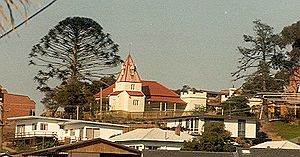Courunga facts for kids
Quick facts for kids Courunga |
|
|---|---|
 |
|
| Location | Monaro Street, Merimbula, Bega Valley Shire, New South Wales, Australia |
| Built | 1870–1880 |
| Owner | Merimbula Veterinary Clinic |
| Official name: Courunga; Munn's Tower House | |
| Type | state heritage (built) |
| Designated | 2 April 1999 |
| Reference no. | 235 |
| Type | House |
| Category | Residential buildings (private) |
| Builders | Matthew Munn |
| Lua error in Module:Location_map at line 420: attempt to index field 'wikibase' (a nil value). | |
Courunga, also known as Munn's Tower House, is a special old home in Merimbula, New South Wales, Australia. It was built between 1870 and 1880 by Matthew Munn. Today, a veterinary clinic owns the property. This historic house was added to the New South Wales State Heritage Register on April 2, 1999, which means it's officially recognized as an important historical place.
History of Courunga
Courunga, once called Munn's Tower House, was built around 1870 by Matthew Munn. His son, Armstrong Lockhart, added more parts to the house around 1880.
Matthew Munn was famous for starting the Maizena Cornflour Company. He owned a lot of land and had big operations in Merimbula. When the cottage was built, Merimbula was a small farming village. The Twofold Bay Pastoral Company first owned the land, and then the Munn family took over.
The Munn family was very important to Merimbula's growth. They owned large areas of land and ran mills in the area. These businesses were key to the town's economy when it was just starting out.
In 1979, a temporary order was put on Courunga to protect it. This meant it couldn't be changed or damaged easily. In 1981, the government planned to make this protection permanent. The owner then suggested a plan to fix up the house and build new homes on the land around it. After some changes, this plan was approved in August 1981. On June 11, 1982, Courunga officially became a permanently protected heritage site.
What Courunga Looks Like
Courunga is a large stone cottage built on top of a hill, so it's easy to see. It has fancy wooden details. Originally, its roof was made of wooden shingles. Later, decorative cast iron poles were added.
The house got its unique look when a two-story tower was added to one corner. This tower is made of timber and has a Victorian Gothic style. Two more timber buildings, called pavilions, were also added. One of these was the kitchen. Both pavilions have decorative walls that look like a castle's battlements.
Why Courunga is Special
Courunga, also known as Munn's Tower House, is a very distinctive stone cottage. It was built around 1870 by Matthew Munn. The amazing additions from 1880 include a two-story timber tower with an attic and two single-story timber pavilions with castle-like tops.
The Munn family played a huge role in the early development of Merimbula. They owned many properties and ran milling businesses that were central to the town's economy. The house's prominent location and its tower, which acts as a landmark, show how important and well-known the Munn family was in Merimbula during its early days.
Courunga was added to the New South Wales State Heritage Register on April 2, 1999, because it met important standards:
- It shows the history of New South Wales.
The Munn family's influence on Merimbula's early growth is clear. The house's visible location and landmark status reflect the family's importance in the town's history.
- It shows great design and creativity.
The building's design is very special. It combines different shapes in a unique way, using a rare castle-like Gothic style. This type of architectural "folly" (a building built mainly for decoration) is uncommon for its time and for the state of New South Wales. The house was placed in a beautiful spot to make it stand out even more. You can see it from far away, making it a true landmark.


